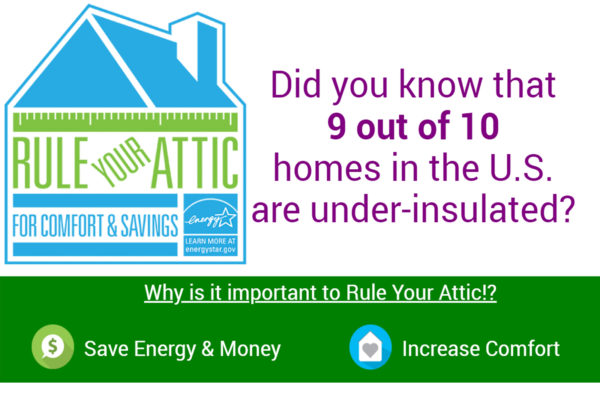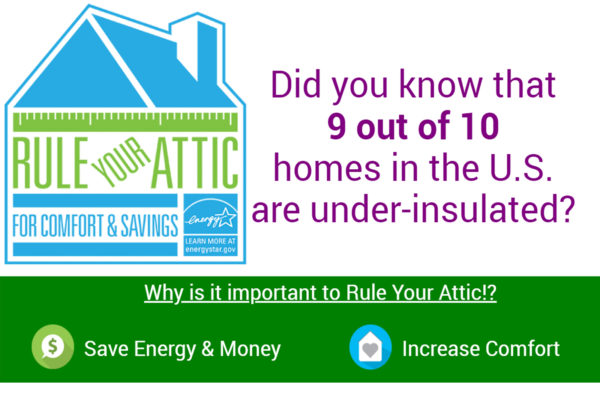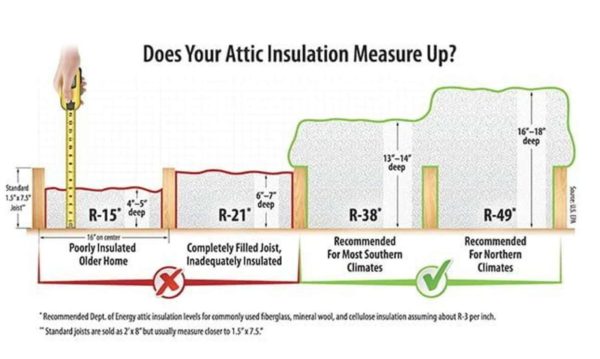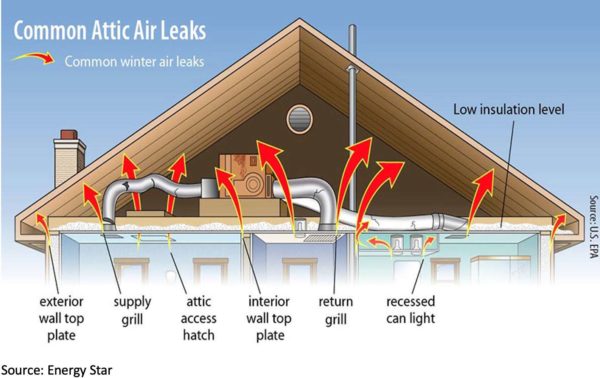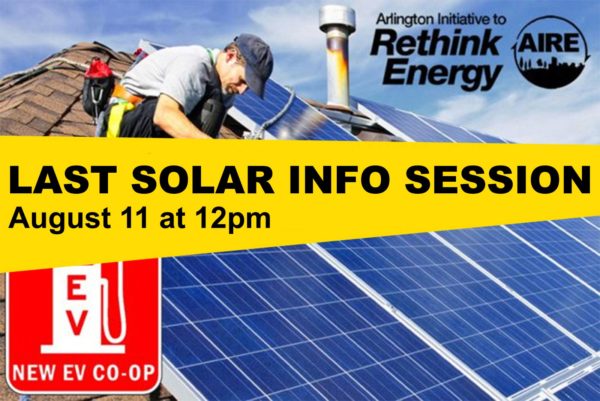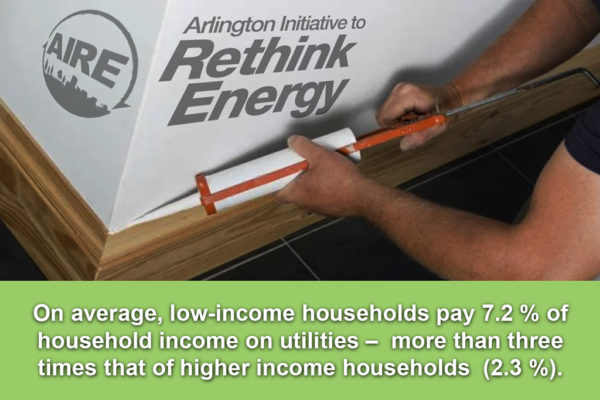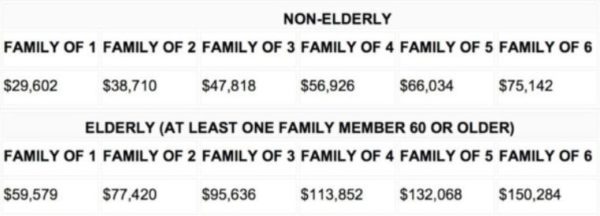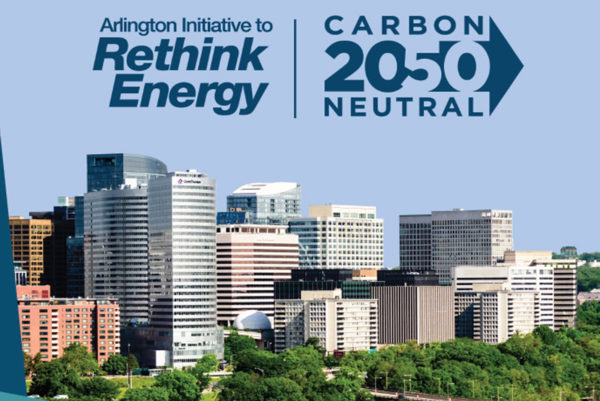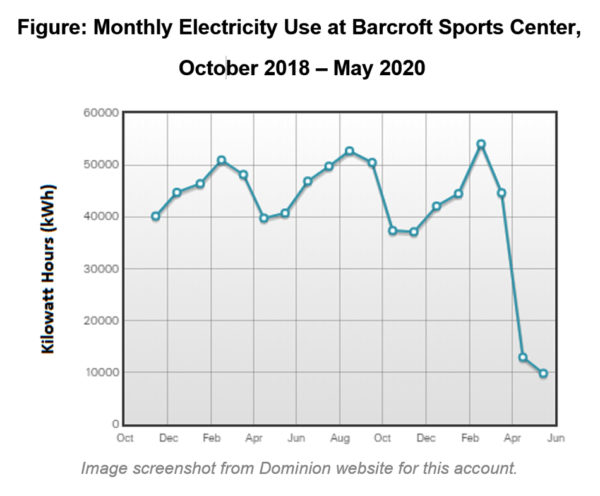This regularly-scheduled sponsored column is written by the Arlington Initiative to Rethink Energy team (AIRE). This county program helps you make smart energy decisions that save you money and leaves a lighter footprint on the environment.
If you cool or heat your home with forced air through vents and duct returns, keep reading…
Duct sealing is a great way to improve home comfort, save money and improve indoor air quality. How much of a difference in-home heating and cooling efficiency do you think duct sealing makes? According to the EPA, it’s as much as 20 percent.
What’s the big issue with duct sealing?
For starters, your air ducts are a vital part of your cooling and heating system. Metal on metal ductwork connections are never a perfect fit, and over time ductwork can separate, creating holes and cracks.
These holes and cracks mean your air conditioning or heating is likely blowing into your walls, crawl space and attic and are creating uneven temperatures in your home. It also means air may be pulled from your crawl space or attic into your home in your air duct returns. That isn’t the healthiest air to breathe.
What’s the fix?
A technician can seal your ductwork where it is visible using an adhesive called mastic, coupled with professional-grade foil tape. Believe it or not, duct tape is never recommended. The technician will also check for disconnected or poorly connected ducts and reattach them.
Most ductwork isn’t visible because it’s behind your walls, in your attic and crawl space, or beneath floors. Sealing that part of your ductwork requires an aerosol-based product. This process seals your ducts from the inside out. It is the most effective way to seal your ducts. This video helps to detail the process.
Take the next step to home comfort and seal your ducts. It’ll ensure your air is healthier, your home is more evenly cooled and heated, and your HVAC system won’t have to work as hard.
Check out the contractors that participated previously in Arlington’s Home Energy Rebate Program and see who has done work in Arlington.
Have questions? Feel free to email us at [email protected].
This regularly-scheduled sponsored column is written by the Arlington Initiative to Rethink Energy team (AIRE). This county program helps you make smart energy decisions that save you money and leaves a lighter footprint on the environment.
We’ve posted before about how to check if your attic insulation needs attention.
Home insulation and air sealing have a significantly greater impact on your home’s energy use and comfort than new windows or doors.
Believe it or not, 9 out of 10 homes in the U.S. are under-insulated. That means that you most likely live in one of them. Plug into these ENERGY STAR how-to videos. This series provides attic insulation tips such as how to measure attic insulation, how to seal air leaks and learn why insulation is important.
- How to Measure Your Attic’s Insulation (30 seconds)
- Should You DIY or Hire a Contractor? (1:09)
- How to Seal Around a Plumbing Pipe (Vent) (55 seconds)
- Why Should You Insulate Your Home’s Attic? (56 seconds)
- How to Cover and Seal a Recessed Light (56 seconds)
- How to Seal an Electrical Box (36 seconds)
- Attic Insulation (15 seconds)
- How to Measure Attic Insulation (1:12)
- Duct Sealing (16 seconds)
Don’t suffer year after year with uncomfortable spaces in your home. In most cases, the fixes aren’t complex, and the cost will likely be less than you expect. You can also take advantage of the tax credit for insulation before the end of the year!
Are you unsure where to start? Do you have technical questions? Our Green Home Choice staff can help answer your questions and point you in the right direction.
For more information about how to Rule Your Attic or Green Home Choice, visit the Green Home Choice Website at www.greenhomechoice.us or contact [email protected]. Please contact us so we can help you take action today.
This regularly-scheduled sponsored column is written by the Arlington Initiative to Rethink Energy team (AIRE). This county program helps you make smart energy decisions that save you money and leaves a lighter footprint on the environment.
1. Replace Your HVAC Filter (And Wear a Mask in Public): Your air filter is the access point for your HVAC system’s air flow, and the place that filters your home from allergens and dirt particles. If you don’t replace your air filter, it clogs up with excess dust. This reduces airflow, or increases resistance, which puts strain on your heating and cooling system. Replace your filter at least quarterly to make sure it’s not too dirty, or subscribe to a filter delivery service for a monthly reminder.
2. Let the Sun in: Leave south-facing blinds open during sunny days and close them at night to lock the heat in. The sun will give you free heating during the day.
3. Thermostat Setting: You can save energy and money by only running your furnace when you are home. Turn your thermostat down when you leave or get a motion sensing thermostat that automatically changes the temperature.
4. Air Flow: If your couch or other items are positioned to block your heating unit or vent, it reduces the amount of air flow. This makes your mechanical system work harder and it takes longer to heat your home. Let the air flow and make sure the vents are clear.
5. Ceiling Fan Setting: Have you ever noticed the switch on your ceiling fan? Your fan should push air down during warm summer months of the year and draw it up during the winter to help create a more even temperature year-round.
6. LED Light Bulbs: LED light bulbs are still the easiest way to save energy and the prices have come way down. They also last longer and use a fraction of the energy compared to incandescents. LED bulbs come in an array of colors and can be dimmed. Swap out your standard bulbs for LED ones to reduce energy costs.
7. High-Performance Showerhead: WaterSense rated showerheads are the way to go. They are tested for performance. They reduce energy used associated with hot water as well as water and sewer costs. If you can’t install one yourself, talk to your landlord or apartment manager about having one installed.
Disclaimer: Your utility savings depends on what is or is not included in your rental agreement or HOA dues. Every action makes a difference.
This regularly-scheduled sponsored column is written by the Arlington Initiative to Rethink Energy team (AIRE). This county program helps you make smart energy decisions that save you money and leaves a lighter footprint on the environment.
As we said in our last post, 9 out of 10 homes in the U.S. are under-insulated. In homes across Arlington, poorly sealed and under-insulated attics are taking money out of homeowners’ pockets in the form of high utility bills.
Now is a good time to double-check your rafters and attic space to ensure they are properly insulated against energy leakage.
To encourage Arlingtonians to take control over their high utility bills this heating season, the U.S. Environmental Protection Agency’s (EPA) ENERGY STAR program is promoting its annual “Rule Your Attic!” campaign.
Adding insulation and sealing air leaks in your attic can help you save up to $200 per year on your home’s annual energy bills and keep you more comfortable. You can also take advantage of the tax credit for insulation before the end of the year!
In addition to energy savings, other benefits to sealing and insulating include: reduced noise from outside; less pollen, dust and pests entering the home; and better humidity control.
Measure Your Insulation
This fall, take the first step to savings by measuring your attic’s insulation. This infographic from the EPA is a good guide to how much insulation your attic should have. If you can see the ceiling joists, you definitely don’t have enough insulation in your attic.
Seal and Insulate
If you determine your attic needs more insulation, install unfaced rolls or batts over the existing insulation; or rent a blower from a home center to blow loose fill insulation into the space.
While you’re in the attic, check for any leaks. Even if you have adequate attic insulation, sealing attic air leaks will enhance its performance and make your home more comfortable.
Common sources of air leaks:
- Behind kneewalls
- Attic entry hatch
- Wiring holes
- Plumbing vents
- Open soffit (the boxes that house recessed lighting)
- Recessed lights
- Furnace flue or duct chaseways (the hollow box or wall feature that hides ducts)
- Basement rim joists (where the foundation meets the wood framing)
- Windows and doors
Additional Resources
Have more questions about insulation, air sealing or home renovations? Contact us at [email protected].
This regularly-scheduled sponsored column is written by the Arlington Initiative to Rethink Energy team (AIRE). This county program helps you make smart energy decisions that save you money and leaves a lighter footprint on the environment.
Home insulation has a significantly greater impact on your home’s energy use and comfort than new windows or doors.
Believe it or not, 9 out of 10 homes in the U.S. are under-insulated. That means that you most likely live in one of them. Older Arlington homes were built when insulation was expensive and fuel was cheap. Many Arlington homes were built with no insulation and are uncomfortably hot in the summer, cold in the winter and have uneven temperatures room-to-room and floor-to-floor.
Do you have uneven temperatures throughout your home? What are you waiting for!? Join other Arlingtonians that already weatherized their homes and are enjoying the benefits of year-round comfort and lower utility bills.
You can also take advantage of the tax credit for insulation before the end of the year!
In most cases, the fixes aren’t complex and the cost will likely be less than you expect. In just one day you can have your home insulated and be comfortable year after year.
Unsure where to start? Check out this list of contractors who participated in previous County programs. Give an insulation contractor a call today to get an estimate.
The sooner you act the more comfortable your home will be.
This regularly-scheduled sponsored column is written by the Arlington Initiative to Rethink Energy team (AIRE). This county program helps you make smart energy decisions that save you money and leaves a lighter footprint on the environment.
Arlington County government relies on the hard work of its many civic-minded volunteers. More than 50 County Commissions and Advisory groups advise the County Board on decisions that affect and benefit our community.
We don’t say it enough, but we really mean it — THANK YOU to each commissioner for your service.
The Environment and Energy Conservation Commission — often abbreviated E2C2 — advises the County Board on a wide range of energy and environmental matters, from climate change to natural resource management. Several openings are expected in the next few months and we invite you to apply online.
Diverse voices are needed! E2C2 is looking for applicants from various professional backgrounds, age ranges, ethnicities, geographic locations in Arlington, and all walks of life to represent Arlington. A strong interest or background in environmental justice issues would be helpful.
Are you interested in energy, environment and climate change-related issues? Are you looking for a way to get involved in your community? This may be just the opportunity you are looking for.
There are several other commissions with openings, too. Visit the County’s Commission page to learn more and apply.
Thank you again to all the Commission and volunteers that continue to help shape Arlington, especially during the weird times we are living through.
This regularly-scheduled sponsored column is written by the Arlington Initiative to Rethink Energy team (AIRE). This county program helps you make smart energy decisions that save you money and leaves a lighter footprint on the environment.
Arlington’s Solar Co-op is still open to new members — but only for two more weeks!
The sign-up deadline is August 21!
You’re invited to our last free webinar to learn about going solar with the co-op.
You’ll get the scoop on:
- Things to consider when putting solar panels on your home
- Ways to finance your new solar system
- How to add a charger for your electric vehicle
- What it means to go solar with the Arlington Solar Co-op. (Spoiler alert: going solar at a discounted group rate, with expert guidance throughout the process.)
You’ll get answers to these questions and more:
- Is my roof good for solar?
- How does solar technology even work?
- What are the benefits of going solar?
- What local and federal laws do I need to know about?
- How can the solar co-op save me money?
- How can I get an electric vehicle charger for my home?
Take advantage of one of the last big federal solar tax credits. This year the solar tax credit will be 26 percent. In 2021, it will be 22 percent and in 2022 and beyond, it won’t be available for homeowners at all.
Please RSVP and join us to learn more:
August 11 at 12 p.m. — Solar and Electric Vehicle Charger Info Session
This regularly-scheduled sponsored column is written by the Arlington Initiative to Rethink Energy team (AIRE). This county program helps you make smart energy decisions that save you money and leaves a lighter footprint on the environment.
High utility bills disproportionately impact those with lower incomes.
On average, low-income households pay 7.2 percent of their income on utilities — more than three times the amount that higher income households pay (2.3 percent).
Families struggling to pay energy bills may sacrifice nutrition, medicine and other necessities, which compound the effects of inequality. Energy efficiency can make a noticeable difference.
The Income and Age-Qualifying Home Improvement program provides in-home energy assessments and installation of select energy-saving products. Single-family homes and multi-family homes (apartments or condos) all qualify.
To help save on energy costs, qualifying Dominion Energy customers can receive a free energy assessment and free energy-saving measures that may include:
- ENERGY STAR qualified LED light bulbs
- Efficient, low-flow showerheads
- Efficient, low-flow faucet aerators
- Pipe wrap insulation for hot water pipes
- Attic insulation and air sealing
Eligible applicants must meet ONE of the following criteria:
- Household income is less than 60% of the state median income
- Household income is less than 120% of the state median income for residents over 60 years of age
These retrofits can make a big difference to some families, so please share this information.
This regularly-scheduled sponsored column is written by the Arlington Initiative to Rethink Energy team (AIRE). This county program helps you make smart energy decisions that save you money and leaves a lighter footprint on the environment.
A major storm has hit our area and your neighborhood just lost power. Your refrigerator stopped humming, your air conditioner ceased and the clock on your stove just went black.
What’s more, you don’t know when the power will be restored. An hour? Tomorrow? What if it’s longer? When the power goes out nothing works (unless you have solar and batteries from Arlington’s Solar Co-op).
If these questions make you uncomfortable, chances are that you don’t have an emergency plan or kit on hand.
This scenario is only hypothetical but we’ve seen it here in Arlington time and time again. Hurricanes, tornadoes, earthquakes — all natural disasters are inevitable. This weekend hurricane Fay is going to narrowly miss Arlington. The key is being prepared. Having an emergency plan and kit can make all the difference.
Since COVID-19 appeared we can’t necessarily bunk up with family, neighbors, or even in a hotel during an emergency without risk.
Below are links to a family-friendly emergency scavenger hunt from Dominion Virginia Power, additional preparedness tips, a link to Arlington’s Solar Co-op and emergency planning resources from Arlington County.
Make a plan and kit today — they could be a real life saver.
This regularly-scheduled sponsored column is written by the Arlington Initiative to Rethink Energy team (AIRE). This county program helps you make smart energy decisions that save you money and leaves a lighter footprint on the environment.
As we move into Phase 2 opening, we will continue our virtual solar and electric vehicle (EV) co-op sessions.
More than 200 homeowners have already installed solar panels as part of our Solar and Electric Vehicle Charger Co-op.
This spring, we’ve already had more than 280 homeowners attend virtual co-op sessions. Sixty-nine families have already had their roofs screened, verified as viable for solar, and they have joined the Co-op.
This June, we’ll continue with 3 additional information sessions. Please RSVP and join us to learn more:
- June 23 — 6 p.m. Info Session link
- June 26 — 12 p.m. Info Session link
- June 30 — 12 p.m. Battery Storage 101 link
For those who may not be familiar, the Co-op helps Arlingtonians buy solar panels and EV chargers at a discounted price through bulk purchasing. The Co-op also provides support to participants to make the purchasing process easy. This year we will also provide information about storing your solar power at home in battery systems.
You can also take advantage of one of the last big federal solar tax credits. This year the solar tax credit will be 26 percent. In 2021, it will be 22 percent and in 2022 and beyond, it won’t be available for homeowners at all.
As you quarantine at home, use this opportunity to learn more about solar power, electric vehicle charging and solar battery storage. Take action today to help our community be carbon neutral by 2050.
This regularly-scheduled sponsored column is written by the Arlington Initiative to Rethink Energy team (AIRE). This county program helps you make smart energy decisions that save you money and leaves a lighter footprint on the environment.
Air pollution is down across Virginia and the rest of the country, due to much lower personal traffic on roadways. You have undoubtedly noticed lighter traffic in Arlington.
The Metropolitan Washington Council of Governments recently reported that traffic in the region had decreased by over 50 percent in late April, and VDOT data shows similar results. The same VDOT site shows even greater reductions during rush hour along Route 29 and I-66 in Arlington.
Similarly, energy use in buildings is down overall in the past two months, with many commercial and institutional properties closed or operating at a fraction of their usual use. Natural gas use is down with the mild spring, and electricity use is down sharply with lower occupancy and mild weather.
Savvy property managers have adjusted accordingly to control costs, shutting off unneeded equipment and setting thermostats back to “unoccupied” settings. As you might expect, Arlington County government has also seen sharp reductions in energy use in community centers and libraries.
Care is taken to not completely shut the buildings off — it is important to maintain proper humidity levels to avoid indoor air quality problems. Emergency lighting and other essential equipment prevent energy use from truly “flat-lining”, but curves like the one below warm the heart of an energy analyst.
Energy managers and planners are seeking insights into how we might maintain some of the energy and cost savings — and reduced pollutant emissions — once society resumes full operation after the COVID pandemic.
Meanwhile, many residents have seen an increase in energy and water bills from staying at home. More cooking, more heating or cooling may be driving household bills up. It may be difficult to assess because COVID hit as winter ended, and the need for air conditioning has been slight thus far. What have you seen in your home energy bills since March?


